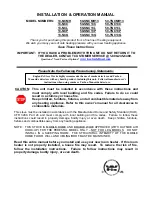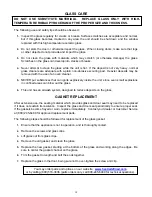
14
FREESTANDING PLACEMENT AND INSTALLATION
The first problem you may encounter is getting your stove into your home -- all of our stove
products are well constructed, which makes them rather heavy. Three to four adults can normally
handle a unit, but we still recommend using a handcart. Never attempt to handle a heating product
alone!!! The door and brick can be temporarily removed to lighten the unit (refer to Brick Layout).
After the unit is placed into position, install the spring handles and attach any optional equipment.
Chimney Connector Pipe
The black pipe must be six inches (6”) in diameter and at least 24 gauge steel pipe. Do not use
aluminum or galvanized steel pipe, as it will not withstand the extreme temperatures generated by
the stove. Also, do not use single wall connector pipe as a chimney -- you must connect your stove
to a chimney comparable to those listed earlier in this manual. The crimped end of your pipe
should be inserted into the flue collar and, by doing this, all the pipe will be reversed. If you use this
method the creosote will run back down the inside of your pipe and not out of the joints onto your
stove. As a safety precaution, all joints should be sealed with high temperature silicone (AC-RTV3)
and secured with sheet metal screws.
For proper operation the chimney connector should be as short as possible and never exceed a
six foot (6’) horizontal run. Horizontal runs of chimney connector pipe should have an upward slope
of one quarter of an inch (1/4”) per foot. You will need to maintain eighteen inches (18”) of
clearance from the ceiling and eighteen inches (18.0”) from the wall when using single wall
chimney connector.
INSTALLATION
1.
Remove all parts from inside the stove body. (If you purchased a leg unit, and it has the factory
packaging, remove the body of the stove from the shroud that it is attached to, referring to
Illustration 7 later in this manual. Those instructions detail how to exchange legs and pedestal,
but removal of the shroud is accomplished in the same manner).
2.
Select the proper location for the stove. These appliances must not be installed any closer than
the minimum clearance to combustible materials shown in Illustration 1. The stove must be
installed on a non-combustible surface as shown in Illustration 1 and Illustration 2.
3.
If non-combustible materials have been installed on the walls, obtain the minimum clearances
from either the manufacturer of these materials or the local building inspector’s office.
4.
Install the stovepipe INSIDE the flue collar on the top of the stove, between the stove and the
chimney.
5.
DO NOT
use a grate to elevate the fire.
6.
A clearance of 18 inches (18”) between the single wall stovepipe and combustible materials is
required. Check with authorities having jurisdiction in your area with any questions.
7.
All pipe sections must be connected with the male (crimped) end toward the stove.
8.
Fasten the stove pipe to the flue collar by the use of three sheet metal screws. Do the same at
each additional joint to make the entire installation rigid.
9.
Maintain the required diameter flue for the entire installation.
10.
If you are connecting the stove to an old masonry flue, be sure to have it inspected for cracks
and general condition. Resizing with a stainless steel liner may be required.
11.
It is recommended that no more than two 90-degree bends be used in the stovepipe installation.
More than two 90-degree bends may decrease the amount of draw, and possibly cause smoke
spillage.
12.
A damper is not required in this installation. Remove the damper plate in the chimney or secure
it in the
OPEN
position.
FAILURE TO FOLLOW THE MINIMUM CLEARANCE REQUIREMENTS MAY RESULT IN
AN UNSAFE INSTALLATION.
Содержание 13-NCC
Страница 20: ...20 Placement of Stainless Steel Burner Tubes for all 13 NCMH 50 SNC13MH and 50 TNC13MH stove models ...
Страница 29: ...29 ...
Страница 57: ...23 ...
Страница 60: ......















































